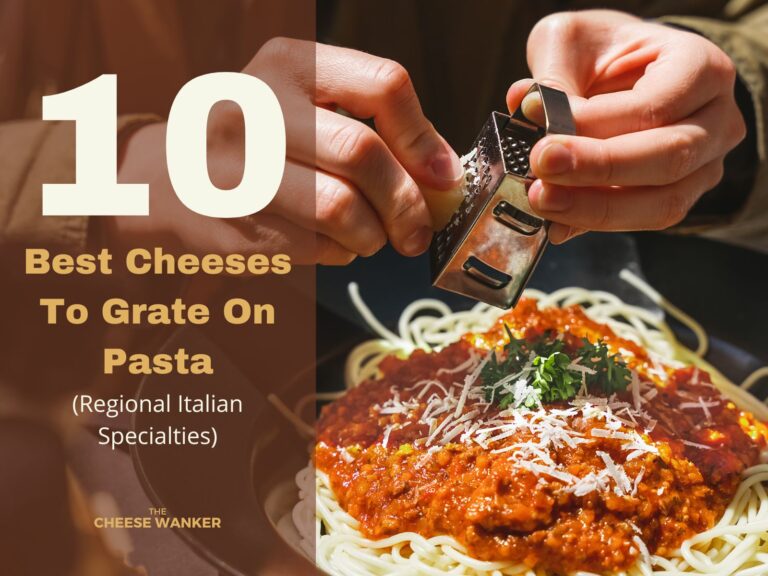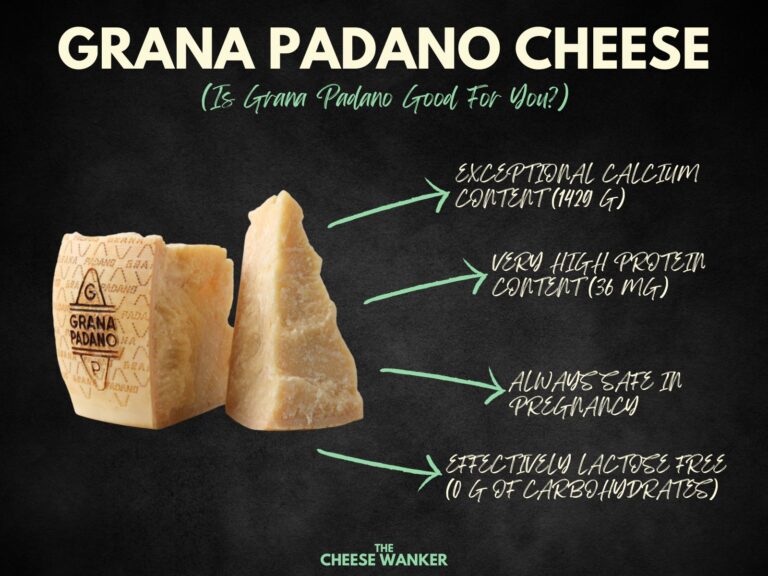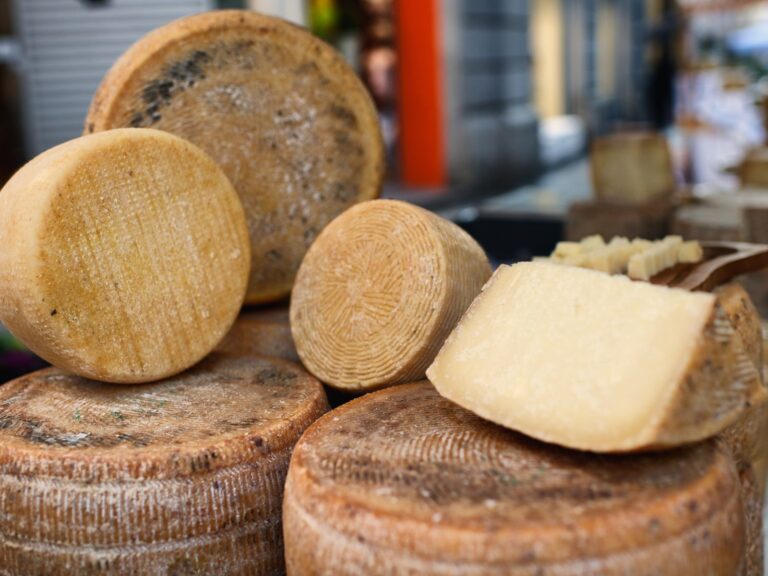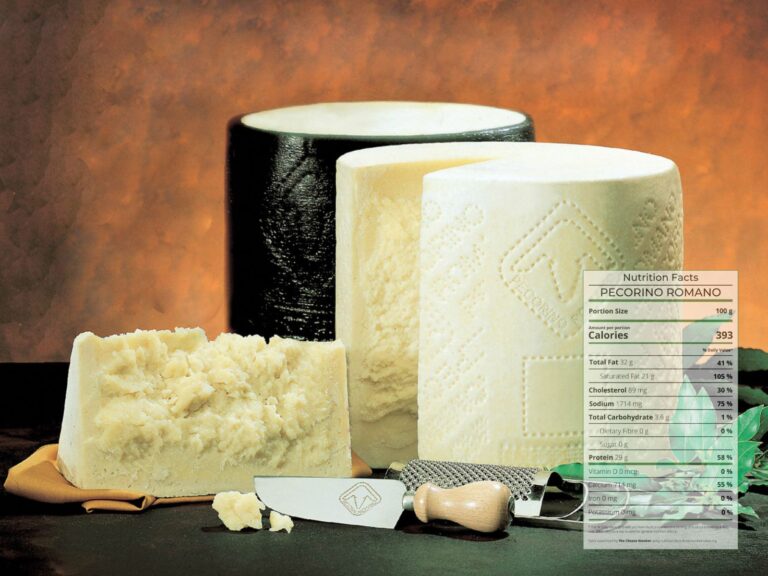With nine different DOP stamps, Pecorino is undoubtedly Italy’s most protected cheese. Thanks to subtle variations in terroir and production, each one of those cheeses has its own unique characteristics. Read on to discover the different types of Pecorino cheese and learn about their origin, production and flavour.
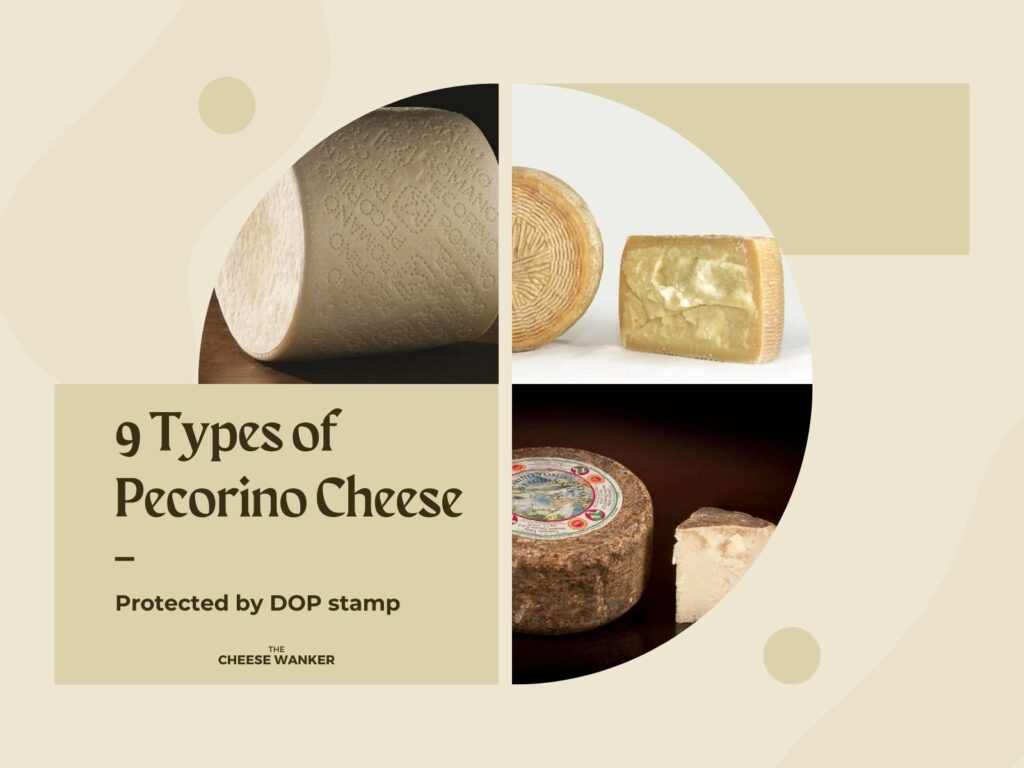
SEE ALSO: Everything you’ve ever wanted to know about Pecorino cheese →
What is Pecorino?
Pecorino is a delicious Italian cheese made from the milk of sheep. It is known for its hard and crumbly texture, and its distinctively salty and tangy flavour that varies based on its age.
Actually, Pecorino has a rich history, dating back thousands of years in Italy. However, the production of Pecorino cheese has remained relatively unchanged over the years.
Today, Italians enjoy Pecorino in various ways. It is often served on its own as a table cheese, sliced or grated. Or you can use it as an ingredient in pasta dishes, salads and other recipes.
You can read more about the history and production of this Italian classic cheese here.
Different types of Pecorino
Presently, Pecorino is produced throughout Italy, with the most famous regions being Sardinia (Sardo), Tuscany (Toscano) and Lazio (Romano). Moreover, each region has its own traditional methods of production and ageing, resulting in a wide variety of Pecorino cheeses with distinct flavours and textures.
In addition to those regions, you can also find some lesser-known Pecorino producers in Sicily, Calabria and Basilicata. Without further ado, let’s have a look at the different regional versions of this famous sheep’s milk cheese.
1. Pecorino Romano
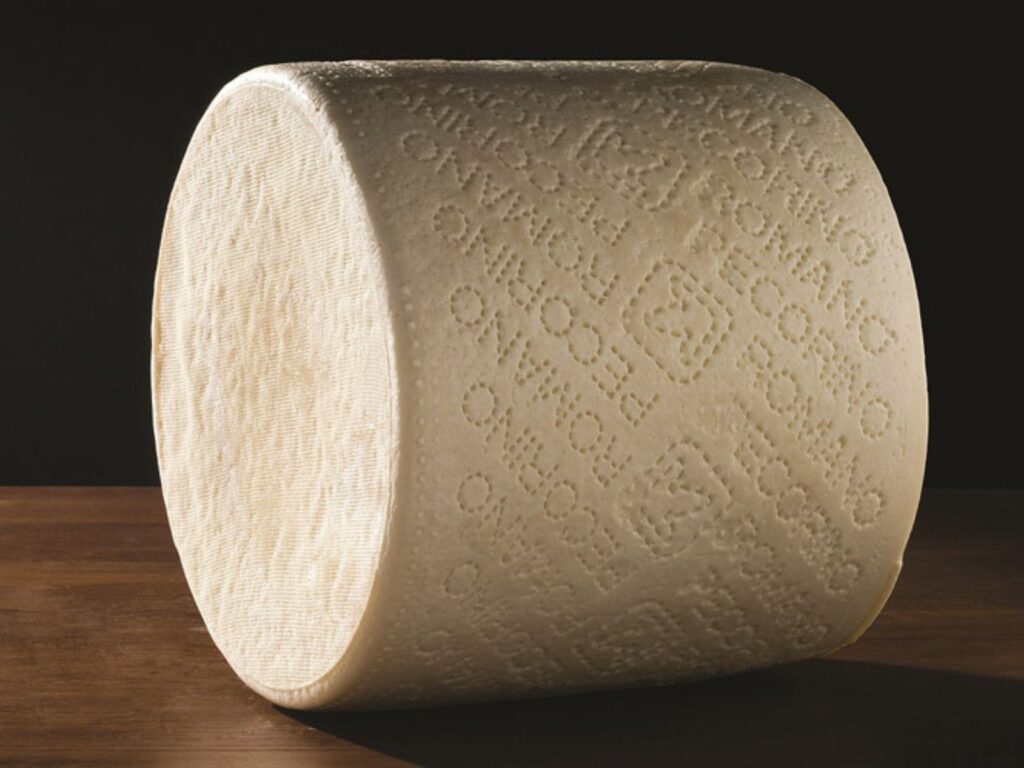
Let’s start our exploration of Pecorino with its most famous version, Pecorino Romano. As its name indicates, this type of Pecorino originates from Rome in the Lazio region. Over time, the production of Pecorino Romano spread to Tuscany and Sardinia.
Pecorino Romano has a thin ivory or straw-coloured rind that can be natural or coated in black wax. Moreover, its paste is hard and compact or slightly eyed, and its colour varies from white to straw yellow.
The ageing period for this type of Pecorino is at least 5 months for the table version and 8 months for the grating cheese. Finally, the cheese’s flavour is aromatic and slightly spicy in the table cheese. On the other hand, the more mature cheese has an intensely spicy flavour with variable sapidity.
Without a doubt, this Pecorino is commonly used in cooking and is known for its ability to enhance the flavours of various dishes. Due to its texture, it is a popular grating cheese used as a topping for pasta dishes like Cacio e Pepe. It can also be used as a garnish for soups and salads.
2. Pecorino Sardo
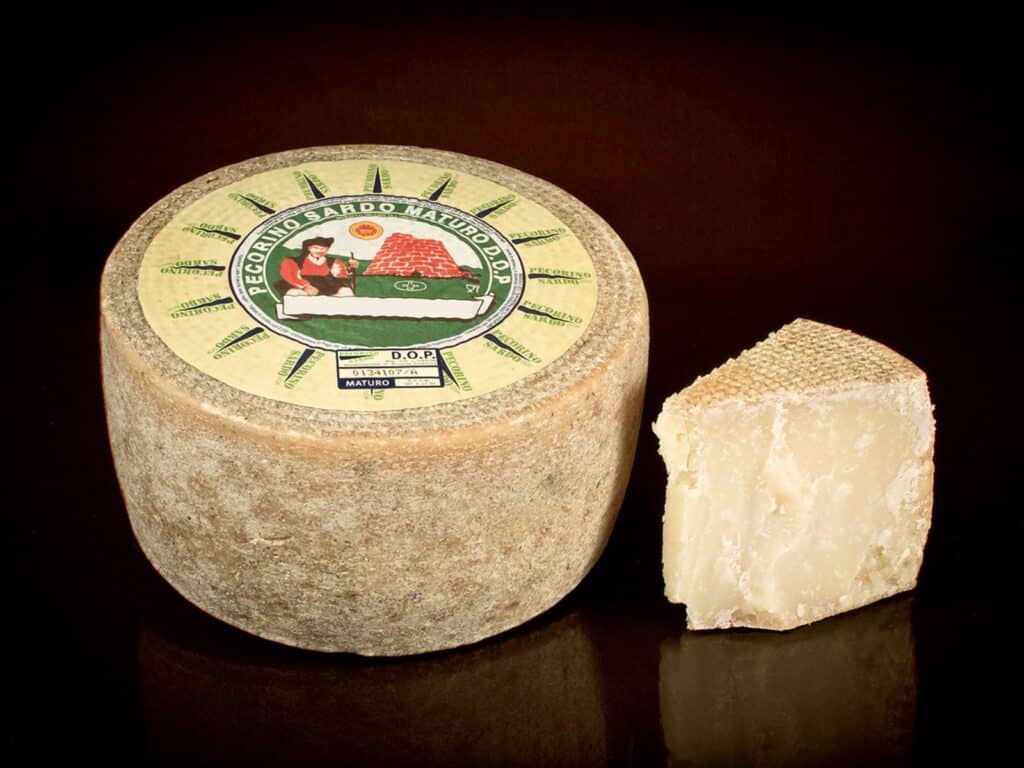
Next, we have Pecorino Sardo, the variety of Pecorino that actually originates from the island of Sardinia. In fact, the DOP “Pecorino Sardo” refers to two different types of cheese: Dolce and Maturo.
Firstly, Pecorino Sardo Dolce wheels weigh up to 2.5 kg and the cheese has a smooth, white or light straw-coloured rind. Moreover, it has a soft, compact or slightly holey texture with a sweet aromatic or slightly acidic flavour.
On the other hand, Pecorino Sardo Maturo weighs between 3 and 4 kg and is aged for at least two months. As a result, it develops a brown natural rind around a white to light-yellow paste with occasional eyes. Moreover, this aged Pecorino has a strong and pleasantly spicy taste.
Sardinians often serve Pecorino Sardo as a table cheese, either on its own or paired with honey, figs or cured meats. It can also be grated and used as a topping for pasta dishes, salads or soups.
3. Pecorino Toscano
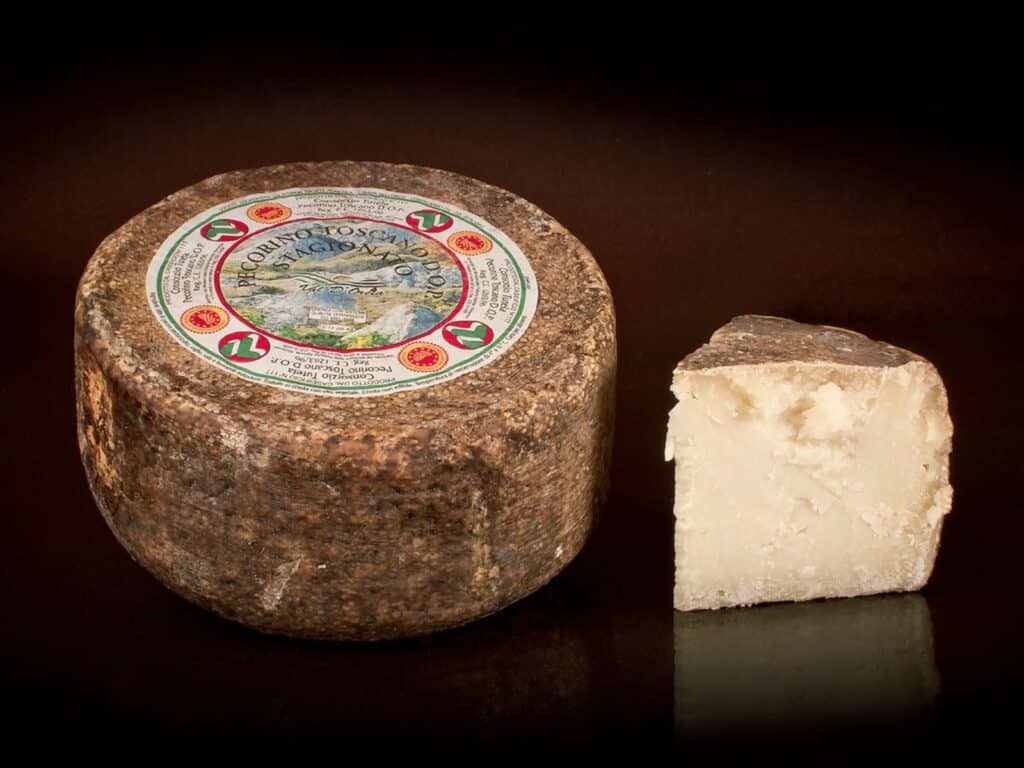
Pecorino Toscano DOP is a cheese that is deeply rooted in the Tuscan dairy tradition, since the Etruscan times. The Etruscans produced large wheels of cheese using vegetable rennet, which could sustain a family for a long time. Today, Pecorino Toscano DOP continues this tradition and is a cheese that is rich in flavour, representing thousands of years of Tuscan dairy heritage.
The production area of this DOP Pecorino includes the entire Tuscany region, as well as specific nearby municipalities in Umbria and Lazio. To be called Pecorino Toscano DOP, the cheese must comply with strict specifications, including the use of sheep’s milk from the designated area of origin.
Pecorino Toscano DOP has a cylindrical shape with a slightly curved edge, and its diameter ranges from 15 to 22 cm. The paste of the cheese is typically white or straw yellow in colour. The flavour of Pecorino Toscano is fragrant and unique, often described as “sweet”. And its flavour becomes more intense and aromatic as it ages without ever becoming spicy.
4. Pecorino Siciliano
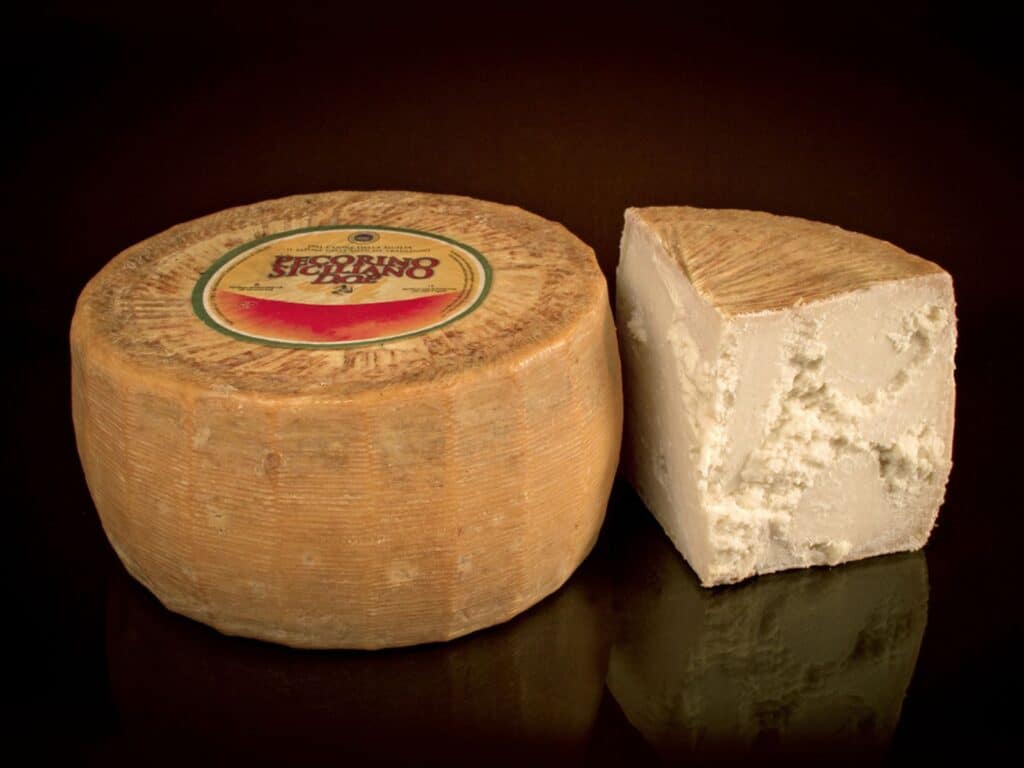
Together with Sardinia, Sicily is one of Italy’s most famous islands. And, of course, it has its own version of Pecorino. In many ways, this cheese is deeply connected to the island. From the terroir in its soil to its unique climate, the island crafts a cheese that is distinctly different to all the other types of Pecorino.
Today, there are four different versions of Pecorino Siciliano with varying maturation times. The youngest and freshest is Tuma (1-3 days). Then you have Primo Sale (10 days), followed by Secondo Sale (45-90 days). And finally, Pecorino Siciliano Stagionato is aged for a minimum of 4 months.
All the aged versions of this cheese develop a hard natural rind due to regular brushing with olive oil. Moreover, the cheeses rest in rush baskets which create a unique pattern on the rind which bears a subtle resemblance to Manchego. As for the cheese’s paste, it is hard and dense ranging in colour from white to pale straw, with fine, evenly distributed holes.
Without a doubt, Pecorino Siciliano is an excellent table cheese and pairs well with bread and olives. Also, you can enjoy this island cheese alongside wines like Marsala (for the younger cheeses) and Etna Rosso or Cerasuolo di Vittoria (for the more mature versions).
5. Pecorino Crotonese
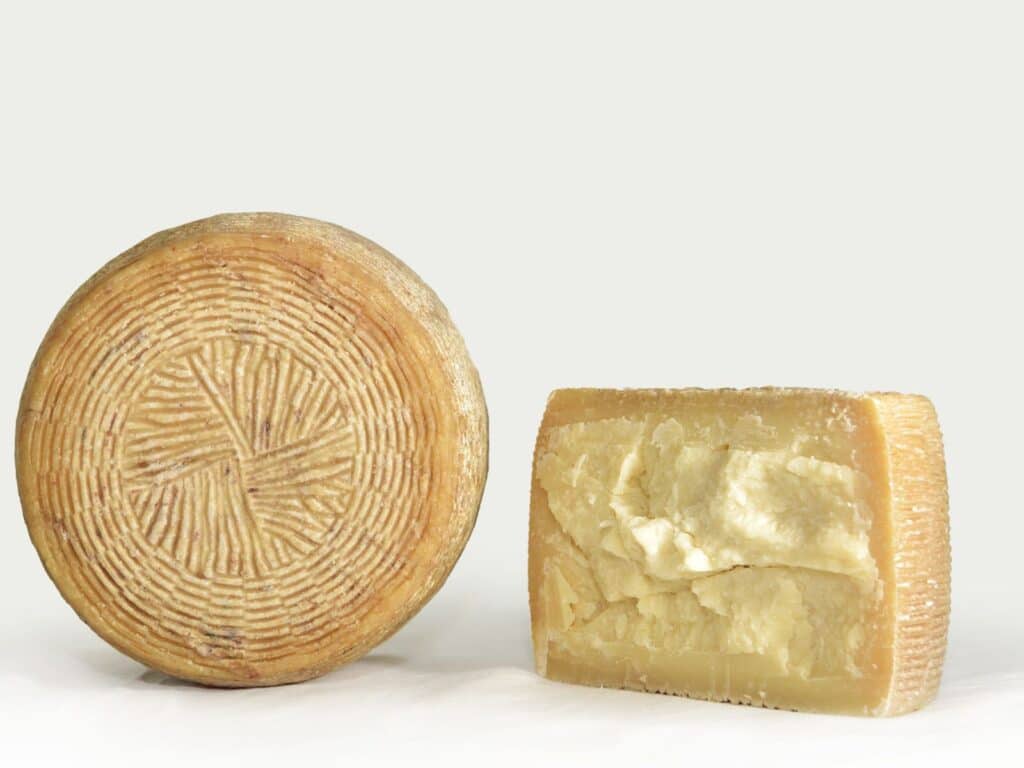
Next, we have the Pecorino from Calabria, Pecorino Crotonese. The earliest mentions of this historical cheese date to 1759 and by the 19th century, it has reached the Naples markets.
Today, Pecorino Crotonese is made in three different versions, Fresco, Semiduro and Stagionato. The fresh version (Fresco) has a thin rind and a soft, creamy paste. On the other hand, the mid-range cheese (Semiduro) has a thicker light-brown rind and a denser paste with eyes. Finally, the mature Stagionato develops a thick hard rind and has a hard, crumbly paste.
The younger cheeses are popular appetisers in Calabria and around the rest of Italy. In fact, they pair beautifully with local sun-dried tomatoes, peppers in oil and Tropea onions. As you would expect, Pecorino Crotonese Stagionato is most used as a grating cheese in the local cuisine.
6. Pecorino di Filiano
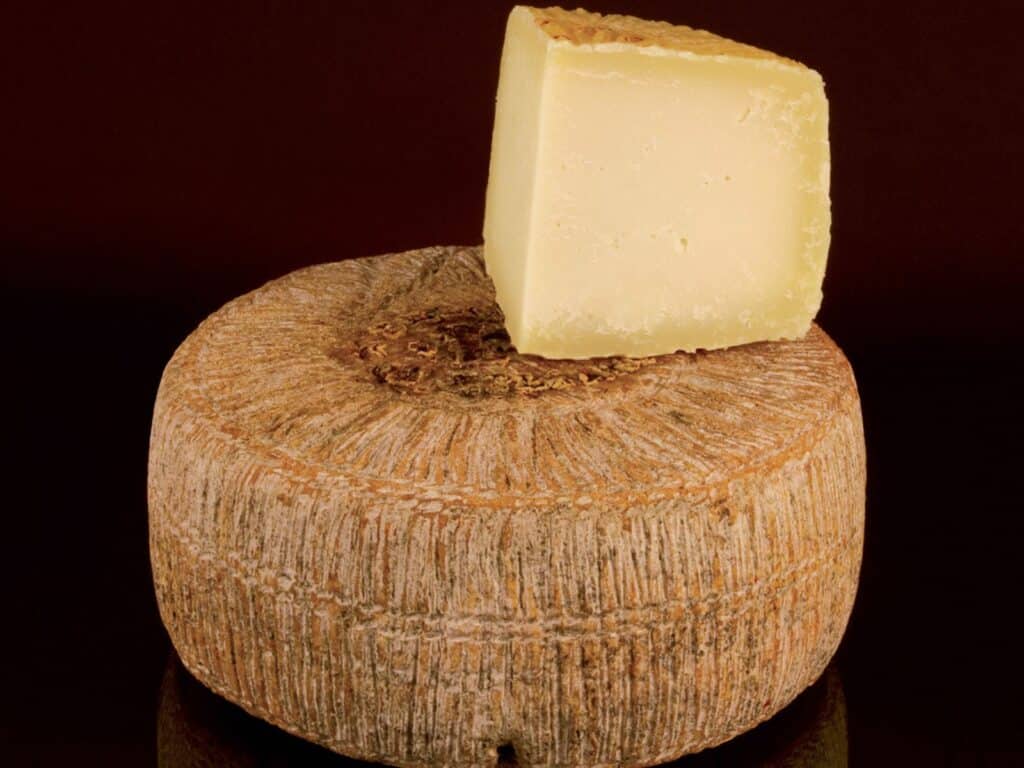
Originating from Basilicata, Pecorino di Filiano gets its name from the practice of local women spinning wool. Actually, the production of this cheese is steeped in local tradition with the recipe passing down from generation to generation. The DOP dictates that the makers of this Pecorino must use local milk and locally sourced rennet.
During maturation, an affineur brushes each cheese with an olive oil and wine vinegar mixture. As a result, this Pecorino develops a hard natural rind. Furthermore, Pecorino di Filiano has a hard, dense and oily paste with occasional holes.
Due to its deep and complex flavour, Italians favour this sheep’s milk cheese as a table cheese. However, it is also a popular ingredient in the local Lucanian cuisine.
7. Pecorino delle Balze Volterrane
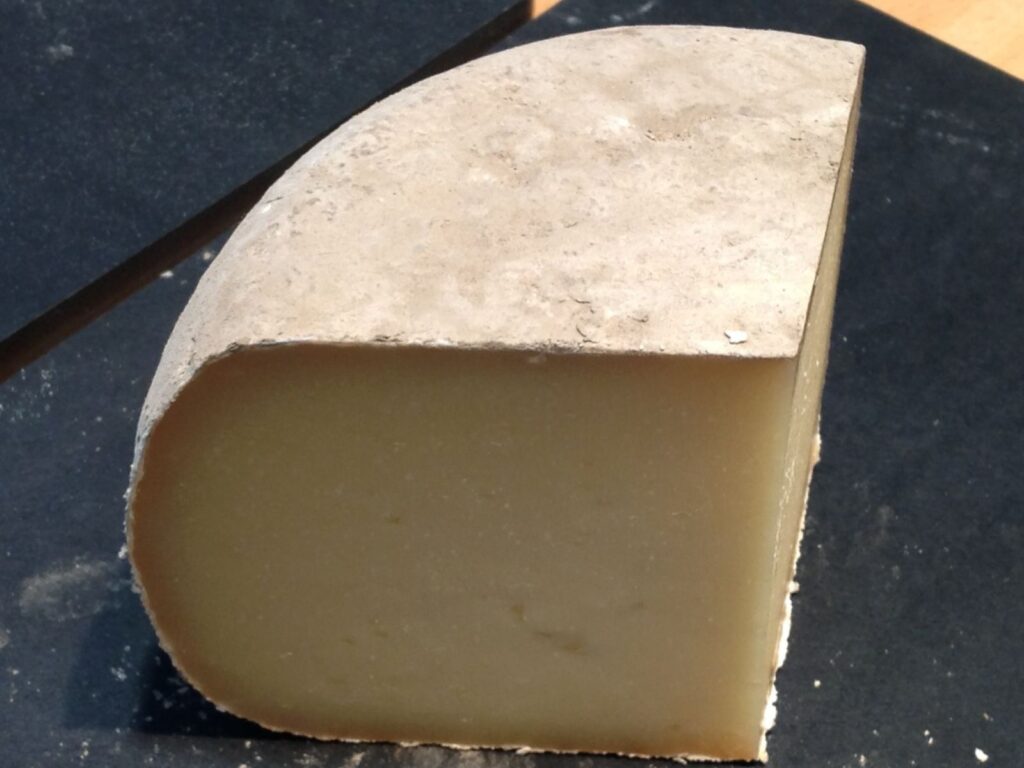
Undoubtedly, the remaining three Pecorino cheeses on our list are less known outside of Italy. Let’s start with Pecorino delle Balze Volterrane from Pisa (Tuscany). This DOP cheese is made with the raw milk of the Italian Sarda sheep. And because cheesemakers use cardoon thistle to coagulate their milk, it is suitable for vegetarians.
Presently, Pecorino delle Balze Volterrane is available in four varieties: Fresco (matured for 4-7 days), Semistagionato (aged between 45 days and 6 months), Stagionato (matured for 6-12 months) and Pecorino da Asserbo, aged for over a year.
During ageing, an affineur treats each wheel of cheese with wood, olive or holm oak ash. Due to this, the cheese develops a grey rind and a unique flavour. Under the rind, its soft paste changes from white to light-yellow as it ages.
The flavour of this cheese has a delicate piquant finish which becomes stronger with ageing. Today, you can find Pecorino delle Balze Volterrane in many traditional Tuscan dishes. But you can also enjoy it on its own or with assorted deli meats and vegetables.
8. Pecorino di Picinisco
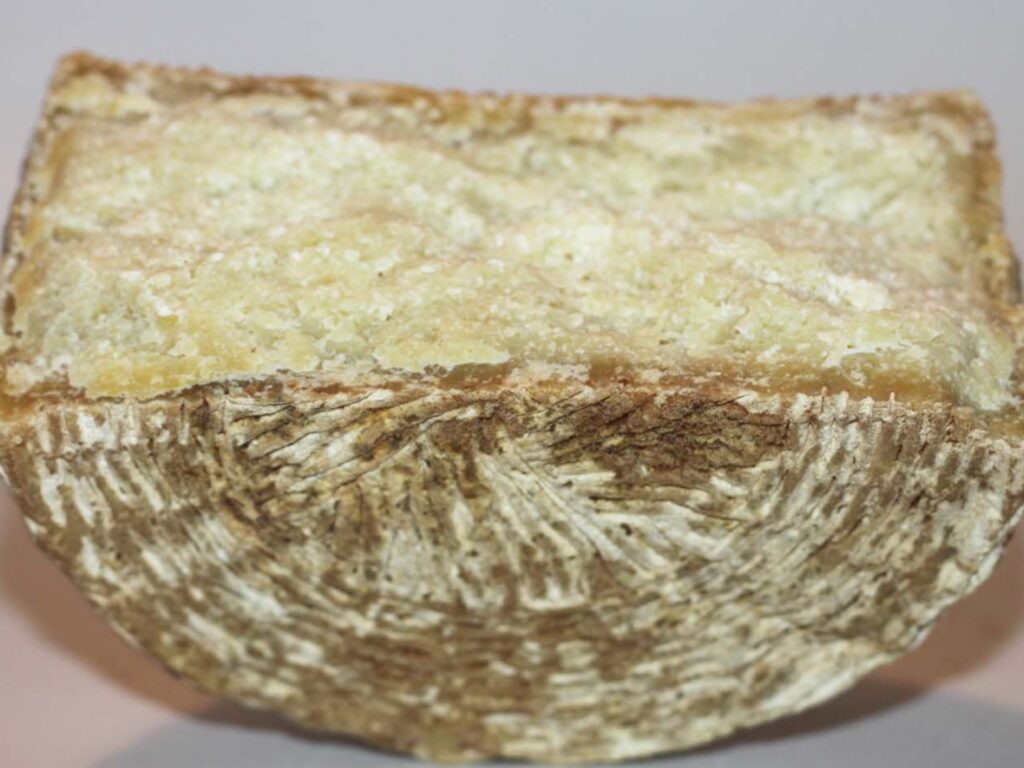
Produced throughout the entire Comino Valley in the Province of Frosinone, Pecorino di Picinisco is an uncooked, hard cheese made with raw sheep milk. It is available in two varieties, Scamosciato (semi-matured) and Stagionato (matured).
The Scamosciato type matures from 30 to 60 days, and the Stagionato for a minimum 3 months. The latter develops a hard brown natural rind and a very crumbly, dense paste. While Scamosciato has a sweet flavour and a strong aroma of mountain pastures, the Stagionato variety is more intense and full-bodied, with pronounced spicy notes.
Pecorino di Picinisco is used as a basic ingredient in many traditional recipes of the Lazio region. However, it also excels as a table cheese. Some traditional pairings include a slice of Pane Casareccio di Genzano, acacia honey, green tomato or red onion jam.
9. Pecorino del Monte Poro
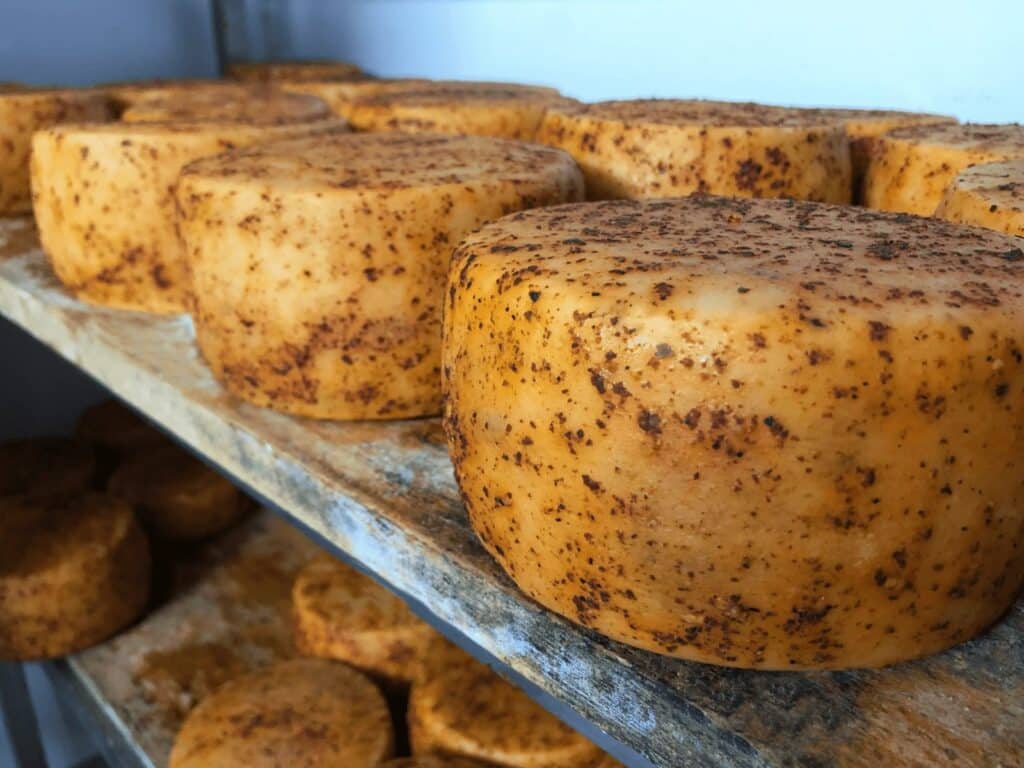
As its name indicates, the final Pecorino on our DOP list hails from Monte Poro in Calabria. With mentions dating back to the 16th century, Pecorino del Monte Poro is one of Italy’s oldest cheeses. In recent times, it had almost disappeared from circulation. An association called Strada dei Sapori del Poro has been set up to help repopularise this ancient cheese.
One distinct feature that separates this cheese from all other Pecorino cheeses is its incredibly complex flavour. It all begins with the flavoursome milk of cows that feed on the aromatic herbs of Mount Poro. In addition to this, cheesemakers brush their cheeses with an olive oil and chilli peppers mixture. As the cheese ages (up to one year), this spicy flavour penetrates its paste.
Pecorino del Monte Poro pairs well with seasonal vegetables and local bread. And is spectacular when served grilled with local sausages, sun-dried tomatoes or preserves. Finally, aged versions of this Pecorino can also be grated onto your favourite Italian dishes.
Summary: not all Pecorino is created equal
Thanks to its nine different DOP listings, Pecorino is undoubtedly Italy’s most varied and protected cheese. And, as you can see, each version has its own unique organoleptic properties. As a result, you may want to serve this versatile cheese as part of a cheese platter. Or grate it on top of your favourite Italian pasta or soup.
What’s your favourite Pecorino? Let me know in the comments below.
